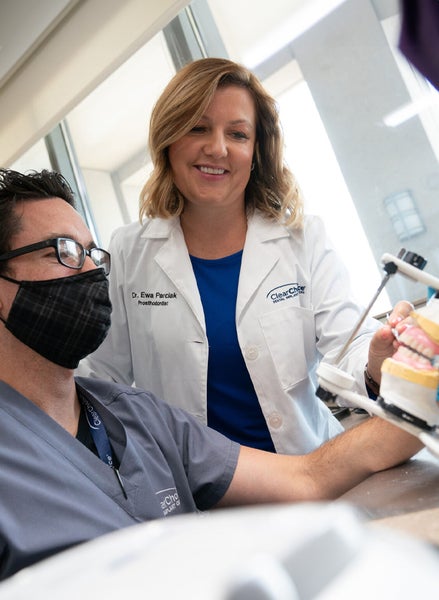Last updated 11.21.2025
How missing teeth change face shape and lead to facial sagging
Explore how missing teeth change face shape and cause sagging—and how tooth replacement can restore facial structure.

Learn more about Dr. Parshan Namiranian

Learn how missing teeth can cause facial sagging and jaw changes. Discover how to replace missing teeth and restore your facial shape with ClearChoice.
Why your teeth are foundational to facial structure
Healthy teeth do far more than help you chew or smile, they also support the shape of your face. Each tooth works with the jawbone and surrounding muscles to keep your cheeks, lips, and bite balanced. When one or more teeth are lost, the changes begin subtly and can progress over time.
Facial support and muscle tone from teeth
Teeth act as natural anchors that maintain vertical height and facial fullness. When a tooth is missing, the bone beneath it no longer receives the stimulation that comes from chewing and bite pressure. As that bone begins to shrink, nearby muscles of the face lose their support, leading to the appearance of face sagging from missing teeth. The muscles of the cheek and lips move against the teeth in smiling and talking, moving food around in the mouth, and closing around a glass to drink water. These movements exercise the muscles and keeps them symmetrical.
Even a single missing tooth can slightly alter symmetry. Over time, the loss of multiple teeth can close the bite and can shorten the lower third of the face. This shorter face and asymmetrical support gives a sunken or aged look.
Consequences of missing teeth beyond facial appearance
The changes from missing teeth extend well past cosmetics.
Bite imbalance. Teeth naturally share the workload of chewing. When some are missing, neighboring teeth may shift or overwork, creating excess pressure on some teeth, causing them to fracture. One-sided chewing can cause the chewing muscles on that side to be overused leading to jaw joint and muscle discomfort.
Nutritional challenges
Speech difficulties, confidence and quality of life. Speech clarity can also change when tongue and lip placement have to adjust to the gaps in the mouth. For many, the visible change in facial structure or smile or speech can affect confidence and social comfort, leading to avoidance of photos or public interactions.
How teeth change face shape over time: Face collapse, sunken cheeks, and wrinkles
When several teeth are missing, especially back molars that support facial height, the lower jaw can rotate upward. This process, sometimes called facial collapse, may make the chin appear closer to the nose and deepen wrinkles around the mouth. It makes the chin much more prominent also.
Sunken cheeks. The cheek fullness is supported by the premolars and molars. When these teeth are missing and the jawbone that held the teeth begins to resorb, the soft tissue in the upper mid-face can lose volume and facial wrinkles form
Wrinkles and lip thinning. As bone resorption progresses, fine lines form around the lips, and the lips themselves may appear thinner.
Signs your facial structure is being affected
You might notice:
A shorter distance between your nose and chin
Deepened folds at the corners of the mouth
Difficulty maintaining your usual facial expression
A collapsed look on one side of your face where several teeth in a row are missing
Loose or ill-fitting dentures
These are signals to discuss tooth-replacement options with a qualified prosthodontist.
Understanding jawbone deterioration and bone resorption
When teeth are missing, the jawbone naturally begins to resorb, a process where the body reuses minerals from the unused bone tissue elsewhere. Over months or years, this can reduce the height and width of the jaw.
Bone resorption and how missing teeth trigger it
Chewing transfers gentle force through tooth roots into bone, stimulating cells that keep bone dense. Without that stimulation, the bone no longer “expects” to bear weight, and the body reshapes itself accordingly.
Link between bone loss and facial aging
Bone loss around the mouth contributes to visible aging more than wrinkles alone. A smaller bone base can make the lower face appear collapsed or hollow, even when skin care or other cosmetic measures are maintained.
Replacing missing teeth to restore facial shape
Tooth replacement is more than restoring a smile; it helps support the structures that define your appearance.
How dental implants help prevent sagging
Dental implant restorations act as artificial tooth roots, helping maintain bone stimulation and stability. When placed into the jaw, the implant integrates with bone tissue over time, known as osseointegration, which may help reduce further resorption. As a result, implants can support natural facial contours and help maintain balanced muscle tone.
Implant-supported restorations, designed by a prosthodontist, anchor directly to the jawbone, supporting long-term strength and a more natural look and feel.
Is it too late to get implants if the face is already sagging
When implants are used, especially to restore an entire arch, the height of the face is restored to its original position, and the facial and lip muscles are able to function against the implant prosthesis. The lost gum fullness is also restored with the full arch prosthesis.
A youthful appearance and symmetry of facial expression and speech can be restored. These improvements in the height of the face can be immediately observed after surgery and the facial muscles continue to strengthen over the next many weeks.
Why implants outperform other options
Long bridges or removable dentures replace visible teeth, but they do not stimulate underlying bone. Over the years, the bone beneath traditional dentures may continue to thin, requiring refitting.
What is the best teeth shape for your face?
Every patient’s ideal tooth design is unique. Prosthodontists consider facial proportions, lip movement, and even personality when designing replacement teeth that complement natural features.
How prosthetic design complements facial harmony
Shape, shade, and tooth length are all tailored to align with facial symmetry. For instance, rounded tooth edges may soften sharp features, while slightly squared shapes can emphasize strength in the jawline. Believe it or not, but size and shape of teeth are very hereditary. Getting a good look at your siblings or children’s teeth can put your prosthodontist on the right path to the original you.
Factors prosthodontists consider in tooth design
Facial dimensions and profile
Skin tone and smile line
Bite alignment and function
Desired brightness and character marks
These aesthetic choices are as much science as art, supported by advanced imaging and on-site lab collaboration at each ClearChoice Dental Implant Center.
Choosing a ClearChoice Dental Implant Center
At ClearChoice Dental Implant Centers, every patient meets a full team—including prosthodontists, oral surgeons, and lab technicians—all under one roof. This integrated approach allows your team to coordinate every stage of care, from digital imaging to final placement.
Your initial visit includes diagnostic scans and a discussion about your health history, goals, and expectations. The team will review treatment options that may best fit your anatomy, lifestyle, and timeline.
ClearChoice prosthodontists design each restoration to fit both facial structure and function, working in real time with on-site labs to refine shade, shape, and bite. The goal is not only a beautiful smile, but a restoration that supports the natural harmony of your face.
Financing options and insurance considerations
While ClearChoice Centers do not accept insurance, patients receive an all-inclusive bill they can submit to their insurer for potential reimbursement. Coverage varies by your insurance plan.
The ClearChoice Insurance Assurance1 and Lifetime Warranty2 programs further help patients navigate ongoing maintenance or future claims.
¹Valid at participating centers only. Discount off fixed full arch dental implants, $2,500 per arch. Maximum discount $5,000. Not valid on prosthodontic appointments or for previous or ongoing work. Cannot be combined with other discounts. Discount taken off usual and customary fees. Contact your local center and show proof of insurance to claim your discount. ClearChoice is not affiliated with any insurance provider, and does not process insurance directly with insurance providers. If you choose to file a claim for reimbursement, you are solely responsible for all communication with your insurance company.
Offer ends 12/31/2025.
² The Lifetime Zirconia Warranty applies to cracks or breaks in the zirconia arch only and not complications with implant integration or ordinary wear and tear. The warranty will be void if the patient fails to follow clinician care instructions, receives treatment outside the ClearChoice Network or is dismissed as a patient. Available in participating ClearChoice Dental Implant Center locations for treatment on or after 03/21/2025.
Take the next step toward restoring your smile
If you’re ready to explore how dental implant restoration can help you replace missing teeth and support your natural facial shape, schedule a free consultation at your local ClearChoice Dental Implant Center. Meet your full team—prosthodontist, oral surgeon, and lab experts—all working together under one roof.
How missing teeth change face shape FAQs
Can tooth-loss-related sagging be reversed?
While lost bone cannot fully regenerate on its own, dental implant restoration may help rebuild facial and muscle support and maintain remaining bone. The earlier missing teeth are replaced, the better your chances of preserving facial shape.
What are the signs of facial changes from missing teeth?
Look for sunken cheeks, wrinkles near the mouth, or changes in bite alignment. These can indicate underlying bone loss or shifting teeth.
Are implants the best way to replace missing teeth?
Implant-supported restorations are considered one of the most comprehensive tooth-replacement options because they anchor to bone and can help maintain facial support. Your prosthodontist will determine if you’re a candidate based on health and bone quality.
Can I choose the best teeth shape for my face?
Yes. Prosthodontists work with on-site labs to customize tooth shape, size, and shade to harmonize with your facial features.



